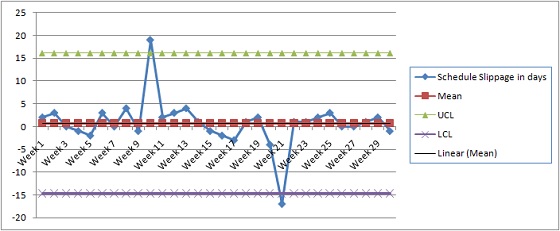

Pareto Chart is a useful technique to understand what the most effecting area of the problems is and where we need to put our efforts.
A success of a project from the problem resolution perspective would not be judged by how many problems we have removed successfully, rather it would be judged by how effectively and successfully we find out about heavy hitter recurring product/service effecting problems and works to remove them.
One important point is that these problems contribute to the remaining most of the problems. Let’s imagine we are investing efforts for the resolution of problems that are in the environment due to other problems which are actually source of these recurring problems, then what will happen? Obviously, these problems will surface again.
What actually I meant to point out here is that it is recommended to discover Vital Few of the problems which are contributing to most of the problems in the environment, Pareto Chart is the tool used to achieve this objective of vital Few identification of problems.
Development of Pareto Chart is directly based on Pareto Principles, which is also known as 80-20 rule.
Pareto Principle states that roughly 80% of the effects come from 20% of causes.
Visualizing and understanding 80% of the problems are relatively easy and sometimes these problems seem too big to hold in our mind and we seek respite to solve them. These are distractions from the real issue which is actually blocking the progress and later these problems would surface again as we didn’t rooted out the source of problems, and still in the environment.
Analysis of Pareto chart is a tool to understand the vital few of the problems and give us a direction to put efforts effectively.
Pareto Chart analysis is performed after generating Pareto diagram and then brainstorming is carried out to understand and recover from vital few.
Roger S. Pressman in software engineering a practitioner’s approach says:
Give your time focusing on things that really matter, but first be sure that you understand what really matter
Based on PMBOK® Guide Pareto Diagram is defined as:
A special form of vertical bar chart and we used to identify the vital few sources that are responsible for causing most of a problem’s effects.
Pareto Diagram Development Process:
Check sheet is used as main input to develop the Pareto chart, please refer link: http://izenbridge.com/blog/check-sheet-as-a-component-of-seven-basic-quality-tool/ to get more details about check sheet;
Let’s see it through the example which we used earlier in Check Sheet Blog.
One of the IT test team member is evaluating work products to detect problems from the specifications agreed. Team may choose to categorise data about quality problems in following categories:
Categories suggested by Roger S. Pressman:>
While examination of work product, test team member assesses the defects and enter frequencies in their respective category of causes this way-
Check Sheet suggested by Roger S. Pressman in software engineering a practitioner’s approach
First two columns of above check sheet are used to develop Pareto chart, as shown below:
Above table is used to develop cumulative frequency and relevant percentage, for that purpose above table data is rearranged in descending order of frequency, as shown below:
Now, the table above is used as an input to develop cumulative frequency and percentage in the following manner-
Now using Excel 2D Column Bar Chart, we develop Pareto Chart as Shown below-
The close analysis shows that IES, MCC and EDR account for 52% of all errors, these are
So, above three categories of causes are identified as Vital Few causes. Once corrected, next items are popped to the top of the stack.
For example, in order to take corrective action to resolve IES, MCC, and EDR team may choose to work on “Collect Requirements” and “Define Scope” Processes.
Team might choose to improve “Facilitated Work Shop” tool of “Collect Requirement” process to improve quality of customer communication and specification for IES and MCC.
In addition, team may also observe to perform more stringent data design reviews as a part of “Define Scope” Process.
It is true that team need to focus on vital few based on cumulative frequency but sometime other things need to be considered, for instance, we may need to select vital few based on serious errors, and then in this case, following table will be used as an input to develop vital few causes, sorted for “Serious Frequency” column-
By examining above table that maximum serious error encountered for IES, EDR, PLT and EDL are the root causes of problem. Now, a Pareto chart will be developed using following columns:
And, steps are repeated as explained above to develop cumulative frequency, percentage and then Pareto Chart.
Benefits of Pareto Chart Analysis
Pareto chart is one of seven basic quality tool, you can watch and listen to the live video presentation on Seven Basic Tools of Quality here:
I hope this blog has sufficiently answered your all queries related to Pareto Chart. Good Luck for your PMP® Certification Exam.
You can share your queries and feedback on our Discussion Forum. You can also log into our YouTube channel watch the video on the related topics.
Enroll to our FREE PMP® Introductory Program to learn more about PMP® certification
No Trainings found